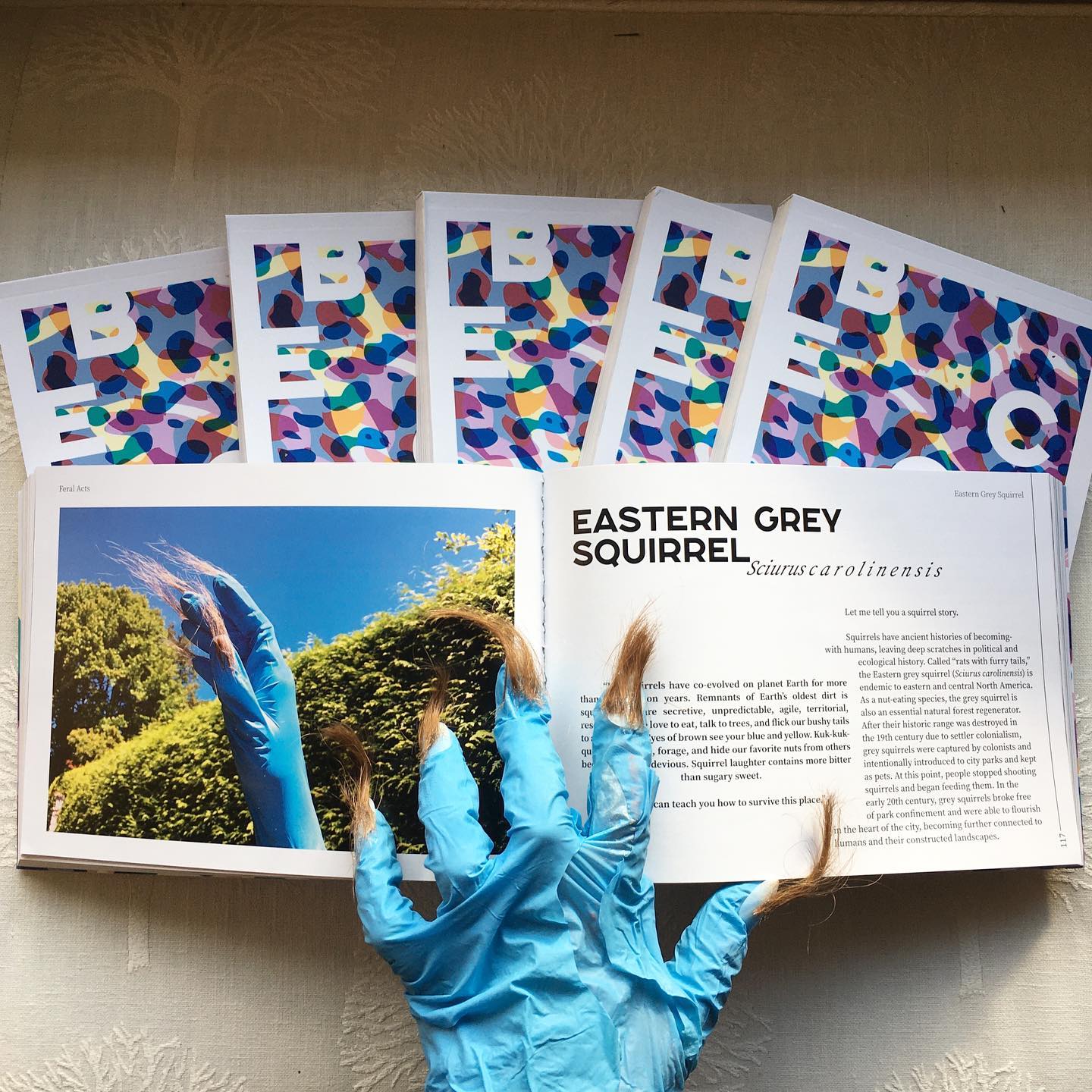Project Description
Becoming Feral
Eastern Grey Squirrel (Sciurus carolinensis)
“We Squirrels have co-evolved on planet Earth for more than 160 million years. Remnants of Earth’s oldest dirt is squirrel. We are secretive, unpredictable, agile, territorial, resourceful; we love to eat, talk to trees, and flick our bushy tails to annunciate. Eyes of brown see your blue and yellow. Kuk-kuk- quaas! We chase, forage, and hide our favorite nuts from others because we are devious. Squirrel laughter contains more bitter than sugary sweet.
We can teach you how to survive this place.”
Let me tell you a squirrel story.
Squirrels have ancient histories of becoming- with humans, leaving deep scratches in political and ecological history. Called “rats with furry tails,” the Eastern grey squirrel (Sciurus carolinensis) is endemic to eastern and central North America. As a nut-eating species, the grey squirrel is also an essential natural forest regenerator. After their historic range was destroyed in the 19th century due to settler colonialism, grey squirrels were captured by colonists and intentionally introduced to city parks and kept as pets. At this point, people stopped shooting squirrels and began feeding them. In the early 20th century, grey squirrels broke free of park confinement and were able to flourish in the heart of the city, becoming further connected to humans and their constructed landscapes.
In my art practice, I spend time observing and researching grey squirrels whose territory surrounds my home. After I saved a dying squirrel in my yard, the intimacy of the encounter evoked a desire to create artwork to document my alliance with the squirrel— thus, Squirrealism was born. Squirrealism narrates origin stories of transformation and coevolution; it describes a process of art-making that channels conceptual and material connections between species to think and make, in Donna Haraway’s words, sympoetically.
During the early days of the COVID-19 pandemic, recycling bins filled with blue nitrile gloves, indexing fears about contagion while also shifting the landscape for urban foragers. As part of my practice, I foraged through bins on my street in squirrealist communion, feeling keenly aware of my own ferality. I was often interrupted by a curious squirrel, a welcome companion during times of isolation. Eastern grey squirrels forage in urban areas and are familiar with human waste.
A grey squirrel was photographed last year in the UK carrying a blue plastic bag to build a nest. Squirrels and humans are mutually constituted by these discarded materials.
Squirrealism chews at the frameworks of normative epistemologies and scratches at the suffocating edifice of Western art history, looking for a way out. It resists domestication and taxonomy, affirming ferality and hybridity. Squirrealism paw-zes to ask: how might squirrels reorient our relationships to human waste, from toxic epistemologies to toxic landfills, from blue plastic bags to blue nitrile gloves?

Yardley, Carollyne. “Eastern Grey Squirrel.” becoming-Feral: a book of beasts. Objet-a Creative Studio, Glasgow 2021, pp. 116-119.

Yardley, Carollyne. “Eastern Grey Squirrel.” becoming-Feral: a book of beasts. Objet-a Creative Studio, Glasgow 2021, pp. 116-119.
Join in-person or online for the launch of becoming-Feral !
Join November 10th for a hybrid launch event for becoming-Feral, a print + digital publication creatively exploring the relations between humans/other-animals.
Through a collection of entries from over 80 international contributors, becoming—Feral proposes a prismatic and multifaceted perspective on our understandings of other-animals and their ‘wildness’ through the re-imagined form of a bestiarum vocabulum (book of beasts). In this curated collection poems, scholarly prose, musical composition, ecological research, lyric essays, performance documentation, and visual art sit alongside each other as we propose ferality in four approaches: Feral Relations, Feral Acts, Feral Collectives, and Feral Futures.
becoming—Feral is a creative research publication which aims to investigate the complex relationships between human/other-animals and the shifting categories of wild/feral/domestic, set within landscapes constantly being altered by global transformations of climate and capitalism. We are interested in exploring reciprocal and responsive multispecies reactions to the act of becoming-Feral.
Learn more + register for your free in-person or online ticket:
In-person | Many Studios, Glasgow
19:00 – 21:00 GMT
Online | Zoom
19:30 – 20:15 GMT
Starting at 19:30, the digital realm will join the celebrations to experience presentations from in-Glasgow and virtual contributors as we launch the publication with readings, video, and feral musical explorations.


